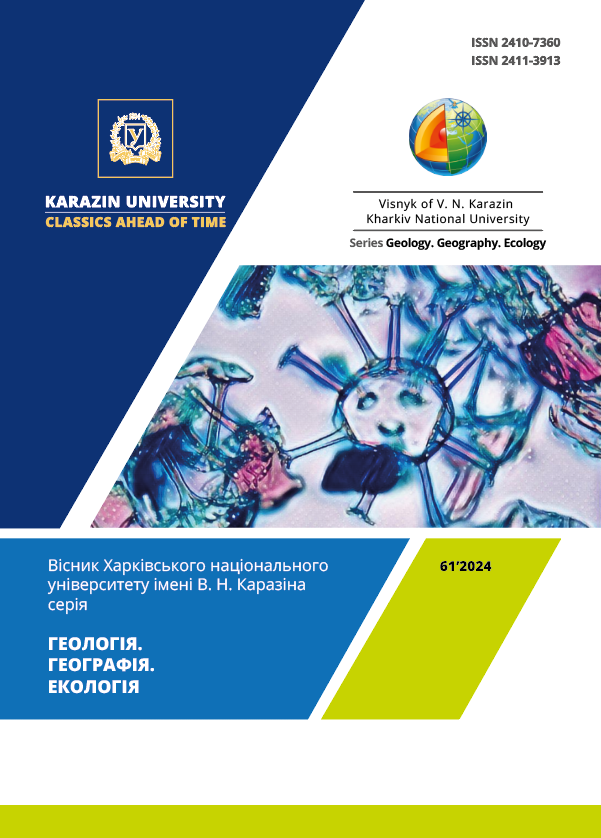Influence of mineral adsorbent on efficiency of fractionation of heavy hydrogen isotopes in aqueous solutions
Abstract
Formulation of the problem. Solving the problem of separation of heavy hydrogen isotopes in aqueous solutions is important for the purification of process waters from the tritium formed in them at the enterprises of the fuel and energy complex. The authors' research established the possibility of cleaning tritiated water from tritium using mineral adsorbents. The purpose of the research was to determine the influence of the mineral adsorbent structure on the efficiency of fractionation of heavy hydrogen isotopes in aqueous solutions.
Materials and methods. To determine the dependence of the fractionation of heavy hydrogen isotopes in the tritium-deuterium-protium aqueous solution H(DT)O on the structure of the mineral adsorbent, eight experimental water-mineral systems were created. The clay rocks used as adsorbents are mainly composed of: kaolinite from the Glukhovetsky deposit (structural type 1 : 1), layered silicates of the structural type 2 : 1 – octahedral montmorillonite and tetrahedral saponite , palyhorskite from the Cherkaske deposit and sepiolite from the Vikalvaro deposit , as well as clinoptilolite. Experiments were performed in stationary conditions. Determination of temperature intervals for extracting moisture fractions from the mineral mass corresponding to certain structural positions in montmorillonite, saponite, palyhorskite and sepiolite was performed using thermogravimetric and differential thermogravimetric analyses. According to the obtained results, the temperature intervals were determined in which, with the help of special equipment, moisture fractions corresponding to certain structural positions in mineral adsorbents were isolated.
Results. It was established for the first time that the fractionation of heavy hydrogen isotopes in water-mineral systems depends on the structural type of the mineral adsorbent. The largest shift in the deuterium/tritium isotopic ratio in the residual solution (decantate) was recorded in systems where the mineral adsorbent is represented by layered silicates – montmorillonite, saponite, and sepiolite. Also, it was established for the first time that hydrogen isotopes were distributed in mineral adsorbents depending on their structural structure. The largest shift in the isotopic deuterium/tritium ratio during surface adsorption occurred in systems with clinoptilolite, palyhorskite, and montmorillonite, which was probably due to the presence of uncompensated surface charges in the mineral substance and the developed specific surface area. The exchange of hydroxyl groups between the H(DT)O solution and the silicate structures of the substrate was accompanied by the largest shift in the deuterium/tritium isotopic ratio in palyhorskite, sepiolite, and kaolinite.
Conclusions. The presence of different types of structural structure in layered and framework silicates, as well as different types of connections in their structures, is of significant importance for the consequences of the interaction of mineral adsorbents with heavy water solutions, which can be accompanied by the separation of heavy hydrogen isotopes and be used for the purification of process waters of nuclear power plants from tritium.
Downloads
References
Pushkarev O.V., Sevruk I.M., Dolin V.V. (2021). Visnyk of V. N. Karazin Kharkiv National University, series "Geology. Geography. Ecology", (55), 73-85 https://doi.org/10.26565/2410-7360-2021-55-07 [in Ukrainian]
Pushkarev OV, Sevruk IM, Zubko OV, Dolin VV (Jr.) (2019). Bulletin of Taras Shevchenko National University of Kyiv. Geology, 1(84): 16-20. https://doi.org/10.17721/1728-2713.84.02 [in Ukrainian]
Pushkarev O.V., Rudenko I.M., Dolin V.V. (Jr.), Zubko O.V., Grechanovskaya O.E. (2017). Mineralogical Journal, 39(2): 64-74. https://doi.org/10.15407/mineraljoumal.39.02.064 [in Ukrainian]
Pushkarev O.V., Rudenko I.M., Rozko A.M., Dolin V.V. (2018). Mineralogical Journal, 40(3): 97-104. https://doi.org/10.15407/mineraljournal.40.03.097 [in Ukrainian]
Pushkarev O.V., Sevruk I.M., Zubko O.V., Dolin V.V., Demikhov Y.M., Skripkin V.V. (2024). Bulletin of Taras Shevchenko National University of Kyiv. Geology. 1(104): 49-54. https://doi.org/10.17721/1728-2713.104.06 [in Ukrainian]
Rudenko I.M., Pushkarev O.V., Dolin V.V., Zubko O.V., Grechanovskaya O.E. (2017). Mineralogical journal. 39, 2: 64-74. [in Ukrainian]
Sobotovich E.V., Bondarenko G.N., Vetstein E.E. (1977). Isotopic and geochemical methods for assessing the de-gree of interrelation between groundwater and surface water. Kyiv, Naukova Dumka, 1977, 154.
Tarasevych Y.I., Ovcharenko F.D. (1975). Adsorption on clay minerals. Kyiv: Naukova Dumka, 352.
Abdou M., Riva M., Alice Ying, C. Day, A. Loarte, L.R. Baylor, P. Humrickhouse, T. F. Fuerst and S. Cho (2020). Physics and technology considerations for the deuterium–tritium fuel cycle and conditions for tritium fuel self sufficiency Nucl. Fusion 61. https://doi.org/10.1088/1741-4326/abbf35
Brindley G.M., (1951). (Editor), X-ray identification and crystal structures of clay minerals, Min., Soc., London.
Brindley G.M., Robinson K. (1946). The structure of kaolinite, Mineral Mag., 27, 242.
Deer, W.А., Howie R.A. and Zussman, J. (1962), Rock-forming minerals. 3, Longmans, London, 317.
Foldvari, M. (2011). Handbook of thermogravimetric system of minerals and its use in geological practice, Buda-pest, 180.
Galan, E. (1996). Clay Miner. 31: 443-453. https://doi.org/10.1180/claymin.1996
Gordon L. (1967). Stewart Fractionation of Tritium and Deuterium in Soil Water Book Editor(s): Glenn E. Stout. Isotope Techniques in the Hydrologic Cycle, 11. https://doi.org/10.1029/GM011p0159
Le Goff, P; Fromm, M; Vichot, L; Badot, PM; Guétat, P. (2014) Isotopic fractionation of tritium in biological sys-tems, Environment International, 65:116-126 https://doi.org/10.1016/j.envint.2013.12.020
Midgley, H.G. (1956). Clay Miner., 16, Publ. by Mineral. Soc., 79-90.
Pauling, L. (1960). The nature of the Chemical bond, Cornel Univ. Press, N.-Y., 644.
Sevruk I., O.V. Pushkarоv, O.V. Zubko (2022). 16th International Conference Monitoring of Geological Processes and Ecological Condition of the Environment. https://doi.org/10.3997/2214-4609.2022580092
Lee S.E., Hatano Y., Tokitani M., Mazusaki S., Oya Y., Otsuka T., Ashikawa N., Torikai Y., Asakura Nobuyuki, Naka-mura H., Isobe K., Kurotaki H., Hamaguchi D., Hayashi T., Widdowson Anna, Jachmich S., Likonen Jari, Rubel M. (2021). Global distribution of tritium in JET with the ITER-like wall. Nuclear Materials and Energy, 26. https://doi.org/10.1016/j.nme.2021.100930

This work is licensed under a Creative Commons Attribution 4.0 International License.





